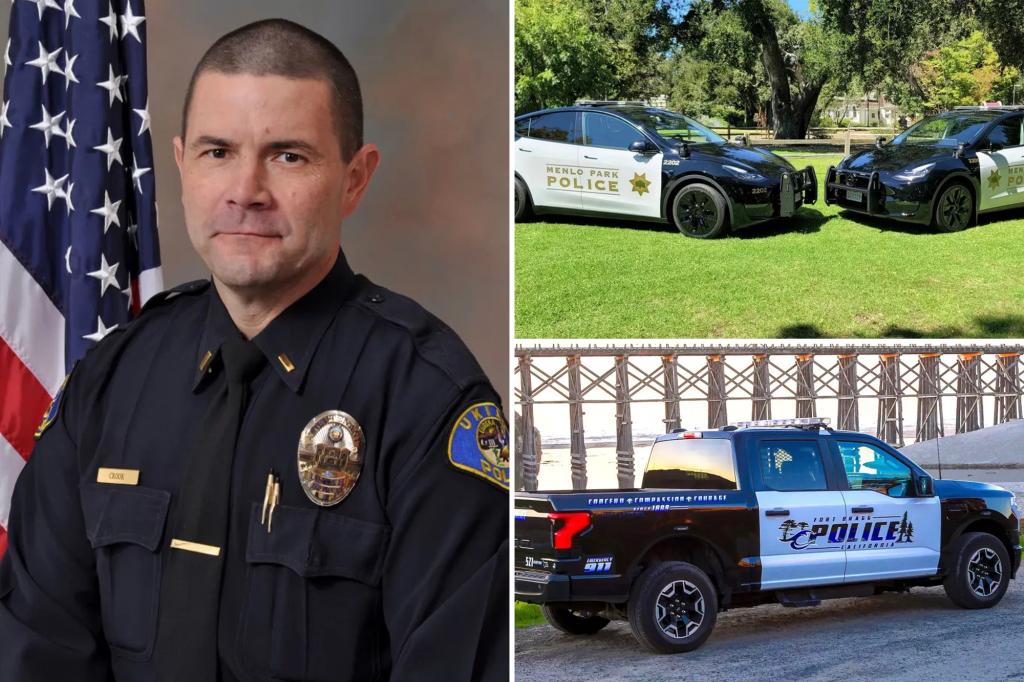California police departments are spending hundreds of thousands of dollars on Teslas to comply with the state’s zero-emissions mandate — only for some to find them “nearly unusable” as squad cars.
Multiple municipalities have started buying modified electric cars since Gov. Gavin Newsom signed a bill in 2020 ordering all vehicles sold in California to be zero-emission by 2035.
The city of Irvine even spent a whopping $150,000 on just one tricked-out Tesla Cybertruck, drawing the ire of taxpayers because it is not for regular patrol but more to turn heads in anti-drug D.A.R.E. programs, according to LAist.
However, other departments have bought Teslas to test as regular squad vehicles — only to report a slew of concerns, including fears officers would be left charging them at unfamiliar stations while still carrying criminals, the San Francisco Chronicle reported.
They include the Menlo Park Police Department, which is just a 6-mile drive from Tesla’s local headquarters.
The department bought 3 Tesla Model Ys, which sell for $50,000, and then spent more on modifications — just for Chief David Norris to conclude they’re not the “patrol cars of the future.”
While a study showed that officers “appreciated the acceleration, steering and vehicle speed,” they found them limited in going off-road or jumping curbs — and reported the autopilot safety caused delays and even stopped the cars when they tried to drive on the side of the road.
Officers claimed the cramped cabin caused their duty belts and bulletproof vests to jut into the passenger seat — “making it nearly unusable,” according to the study.
Ukiah, the largest city in Mendocino County, spent $150,000 on two modified Tesla Model 3s, which Police Chief Cedric Crook said was necessary to meet the “big push from the city’s Climate Initiative,” according to the Chronicle.
However, the only shop able to modify them was 500 miles away — and said the work could take months, the report said.
The chief was also worried about the availability of charging stations, noting out that officers often have to transport prisoners, suspects or victims hundreds of miles to or from other jurisdictions — more than the Tesla would take them without a lengthy stop.
The cars also “only have room for one prisoner,” Crook said, limiting cops’ ability to hold multiple suspects, and his officers reported difficulty getting in and out of the sleek vehicle with their 20-plus pound belts.
A main safety concern, Crooks said, is the lack of an engine block, which police officers are taught at the academy to hide behind during a gunfight.
“I’m not ready to put an officer in a Tesla,” the police chief told the Chronicle.
The Fort Bragg Police Department decided to forego Teslas for five electric Ford F-150 Lightning trucks, and fully equipped the department’s parking lot with chargers.
As the “most popular selling trucks in America,” the Ford’s are easy to get modified and repaired, versus “tricky” Teslas needing “a Tesla technician to do a lot of the work. And they’re out of service for quite some time,” Chief Neil Cervenka told the Chronicle.
His more positive experience suggests that police should not give up on going green.
“Tesla isn’t the right answer in the law enforcement market currently for electric adoption,” Cervenka suggested, “but there might be better options.”
Tesla did not immediately respond to a request for comment Wednesday.
Read the full article here

